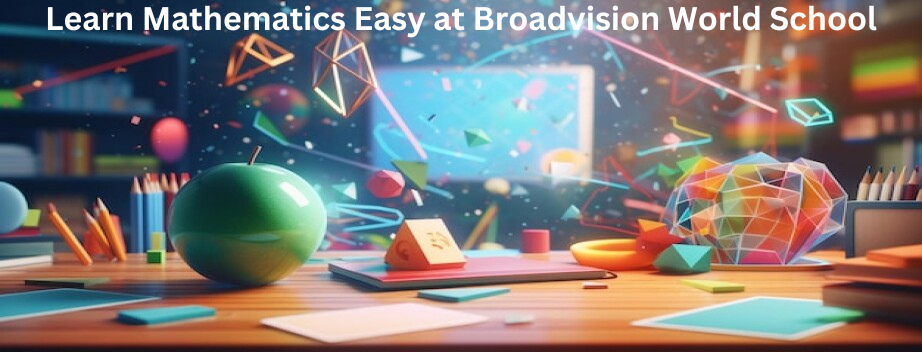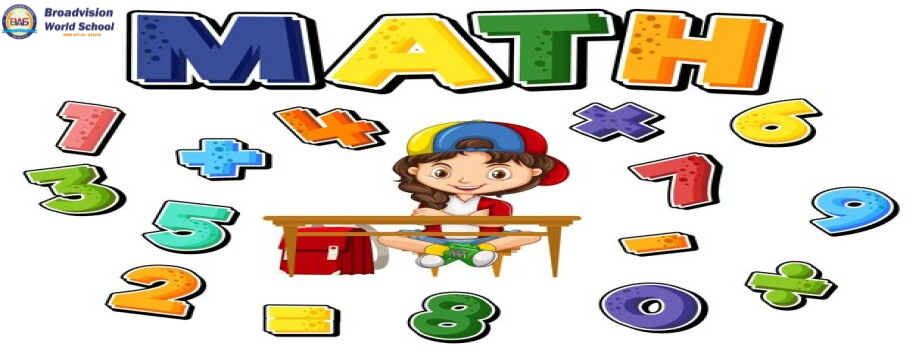Giving your child the best start in life
-
First Floor, 10A Chandos Street London New Town W1G 9LE
Get In Touch
Monday to Friday: 8.30am – 02.00pm
Saturday, Sunday: Close
Email: user@domainname.com
Phone: +44 (0) 207 689 7888

Learning math can be a daunting task for many children, but it doesn’t have to be. At Broadvision World School, we believe in making Mathematics Easy and enjoyable for all students. Whether your child is just starting their math journey or needs a little extra help, this guide will provide you with the tools and techniques to help them succeed.
Learning math in an easy and engaging way has numerous benefits. It helps children build confidence, reduces anxiety, and fosters a love for learning. When math is made simple and fun, children are more likely to develop a positive attitude towards the subject, leading to better academic performance and a solid foundation for future learning.
Many children experience math anxiety, which can hinder their ability to learn and enjoy the subject. By using techniques that make math approachable and less intimidating, we can help children overcome this anxiety. Fun activities, interactive lessons, and positive reinforcement are key strategies in reducing math-related stress.
A strong foundation in Basic Math Concepts is crucial for future success. At Broadvision World School, we emphasize the importance of mastering fundamental skills such as addition, subtraction, multiplication, and division. These skills are the building blocks for more advanced math topics and real-life problem-solving.
The first step in learning math is understanding numbers and counting. Children learn to recognize and write numbers, count objects, and understand the concept of quantity. Simple exercises like counting toys or steps can make learning numbers fun and relatable.
Once children are comfortable with numbers, they move on to addition and subtraction. Using visual aids like number lines and counters, children learn to add and subtract in a way that makes sense to them. For example, using apples to demonstrate adding and taking away items helps children grasp these concepts quickly.
Multiplication and division are introduced as repeated addition and subtraction. Using arrays, grouping objects, and simple word problems, children learn to understand these operations. Real-life examples, such as sharing snacks among friends, make these concepts easier to grasp.
Incorporating games and puzzles into math lessons is a great way to Make Learning Math fun. Games like Sudoku, math bingo, and card games that involve numbers help children practice their skills while having fun. Puzzles that require logical thinking and problem-solving also enhance their math abilities.
There are numerous interactive math apps available that turn learning into a game. Apps like Mathletics, Khan Academy Kids, Prodigy and DragonBox make math engaging and interactive. These apps provide instant feedback and adapt to the child’s learning pace, making them an excellent tool for reinforcing math concepts.
Applying math to real-life scenarios helps children see the relevance of what they’re learning. Activities like cooking (measuring ingredients), shopping (calculating costs), and planning trips (estimating travel time) provide practical applications of math skills. This approach makes math tangible and meaningful.
Websites like Coolmath4kids, Funbrain, and Math Playground offer a plethora of resources, including games, videos, and worksheets. These sites make learning math interactive and enjoyable, providing a variety of activities to suit different learning styles.
Traditional resources like workbooks and worksheets are still valuable tools for learning math. They provide structured practice and help reinforce concepts taught in the classroom. Workbooks from publishers like Kumon and Scholastic are particularly popular for their comprehensive and age-appropriate content.
Online tutorials and videos are excellent resources for visual and auditory learners. Websites like YouTube and educational platforms like Khan Academy, Byjus offer step-by-step explanations of math concepts. These resources can be particularly helpful for children who need additional support outside of the classroom.
At Broadvision World School, we understand that every child learns at their own pace. Personalized learning plans tailored to each student’s strengths and weaknesses ensure that they receive the support they need to succeed. These plans are regularly updated based on the child’s progress.
Small group instruction allows for more individualized attention and interaction. Teachers can provide targeted support and address specific areas where students may be struggling. This approach fosters a collaborative learning environment and encourages peer-to-peer learning.
Hands-on learning is a core part of our teaching philosophy. Using manipulatives like blocks, beads, and other tactile materials, children can physically interact with math concepts. This method helps them understand abstract ideas in a concrete way, making learning more effective and enjoyable.
Mathematics is the study of numbers, shapes, and patterns. It helps us understand the world around us and solve problems in everyday life. At Broadvision World School, we believe in making math enjoyable and accessible for all children.

Numbers are symbols that represent quantities. They help us count, measure, and label things.
Counting is the process of determining the number of elements in a set. Let’s start with counting from 1 to 10.
1, 2, 3, 4, 5, 6, 7, 8, 9, 10
Addition is combining two or more numbers to get a total.
Example: 2 + 3 = 5
If you have 2 balloons and get 3 more, you have 5 balloons in total.
Subtraction is taking one number away from another.
Example: 5 – 2 = 3
If you have 5 candies and eat 2, you have 3 candies left.
Multiplication is repeated addition.
Example: 3 x 2 = 6
This means 3 groups of 2, or 2 + 2 + 2 = 6.
Division is splitting into equal parts.
Example: 6 ÷ 2 = 3
This means splitting 6 into 2 equal groups of 3.
A fraction represents a part of a whole.
Example: 1/2 means one half.
Decimals are another way to represent fractions.
Example: 0.5 is the same as 1/2.
Geometry is the study of shapes and their properties.
Positive reinforcement can significantly boost a child’s confidence and motivation. Praise their efforts, celebrate their successes, and provide constructive feedback. This approach helps children develop a growth mindset and encourages them to persevere through challenges.
Celebrating small achievements, such as mastering a new math concept or improving test scores, can keep children motivated. Use reward systems like stickers, certificates, or extra playtime to acknowledge their hard work and progress.
Fostering a love for learning is essential for long-term success. Encourage curiosity, ask open-ended questions, and explore math topics that interest your child. When children are genuinely interested in what they’re learning, they’re more likely to stay engaged and retain information.
Parents play a crucial role in their child’s math education. Helping with homework and providing additional practice at home can reinforce what is learned in school. Make homework time a positive experience by offering support and encouragement.
Engage your child in math-related activities at home. Play math games, solve puzzles together, and incorporate math into everyday tasks like cooking and shopping. These activities Make Learning Math fun and part of daily life.
Regular communication with teachers ensures that parents are aware of their child’s progress and can provide support where needed. Attend parent-teacher conferences, ask for feedback, and collaborate with teachers to help your child succeed.
Interactive whiteboards in classrooms make learning dynamic and interactive. Teachers can use them to demonstrate math problems, show videos, and engage students in interactive activities. This technology makes lessons more engaging and helps students visualize complex concepts.
Educational math software provides interactive lessons and practice problems. Programs like MathBlaster and DreamBox adapt to the student’s learning level and offer personalized instruction. These tools Make Learning Math more engaging and effective.
Virtual classrooms offer flexibility and access to a wide range of resources. Students can participate in live lessons, access recorded sessions, and collaborate with peers online. This approach is particularly beneficial for remote learning or additional support outside of school hours.
Create a dedicated math corner at home with resources like books, manipulatives, and educational games. This space should be inviting and free from distractions, encouraging children to explore math concepts in a comfortable environment.
Encourage your child to ask questions and explore math topics that interest them. Foster a sense of curiosity by discussing how math applies to the world around them. This approach helps children see the relevance of math in everyday life.
Books and toys that incorporate math concepts can make learning fun and engaging. Look for storybooks with math themes, puzzle books, and educational toys like building blocks and counting games. These resources make math accessible and enjoyable.
Math phobia can be a significant barrier to learning. Address this issue by creating a supportive and non-judgmental environment. Use positive reinforcement, break down complex problems into manageable steps, and provide plenty of practice opportunities.
Complex math problems can be intimidating. Teach children to break them down into smaller, more manageable parts. For example, solving a multi-step word problem can be simplified by tackling one step at a time. This approach makes problems less overwhelming and easier to solve.
If your child is struggling with math, don’t hesitate to seek extra help. Tutoring, after-school programs, and online resources can provide additional support. Collaborate with teachers to identify areas of difficulty and develop strategies to address them.
After-school math clubs offer a fun and supportive environment for children to practice and improve their math skills. These clubs often include games, competitions, and collaborative projects that Make Learning Math enjoyable.
Math competitions and Olympiads provide opportunities for children to challenge themselves and showcase their skills. Participating in these events can boost confidence and foster a competitive spirit. They also offer a chance to connect with peers who share similar interests.
Summer math camps provide intensive learning experiences in a fun and relaxed setting. These camps often include hands-on activities, field trips, and interactive lessons that make math exciting. They are a great way to keep children engaged in learning during the summer break.
Regular assessments and feedback are essential for tracking progress and identifying areas for improvement. Use quizzes, tests, and informal assessments to monitor your child’s understanding of math concepts. Provide constructive feedback to help them grow.
Implement reward systems to motivate your child and celebrate their achievements. Rewards can be simple, like stickers or extra playtime, or more substantial, like a special outing. Recognizing their hard work and progress encourages continued effort and enthusiasm.
Sharing success stories can inspire and motivate children. Highlight examples of individuals who have overcome challenges and achieved success in math. Discussing role models and real-life success stories shows children that hard work and perseverance pay off.
Learning math doesn’t have to be a struggle. With the right approach, resources, and support, children can learn math easily and enjoyably. At Broadvision World School, we are committed to providing an engaging and supportive learning environment that helps every child succeed. Encourage your child to embrace math, celebrate their successes, and watch as they develop a lifelong love for learning.

Children can start learning Basic Math Concepts as early as preschool. Activities like counting, sorting, and recognizing shapes help build a foundation for more advanced math skills.
If your child struggles with math, provide extra support at home, seek help from teachers or tutors, and use interactive tools and resources to teach Math Easily. Encouragement and patience are key to helping them overcome challenges.
Yes, online math games can be very effective for learning Math Easily. They make math fun and interactive, providing immediate feedback and adapting to the child’s learning pace.
Some good math apps for children include Mathletics, Khan Academy Kids, DragonBox, and Prodigy. These apps offer engaging and educational content tailored to different age groups and learning levels to make Mathematics Easy.
Make math fun by incorporating games, puzzles, and real-life scenarios into learning. Use positive reinforcement, celebrate small wins, and explore math topics that interest your child. This wil make Mathematics Easy for your child.

Comments are closed